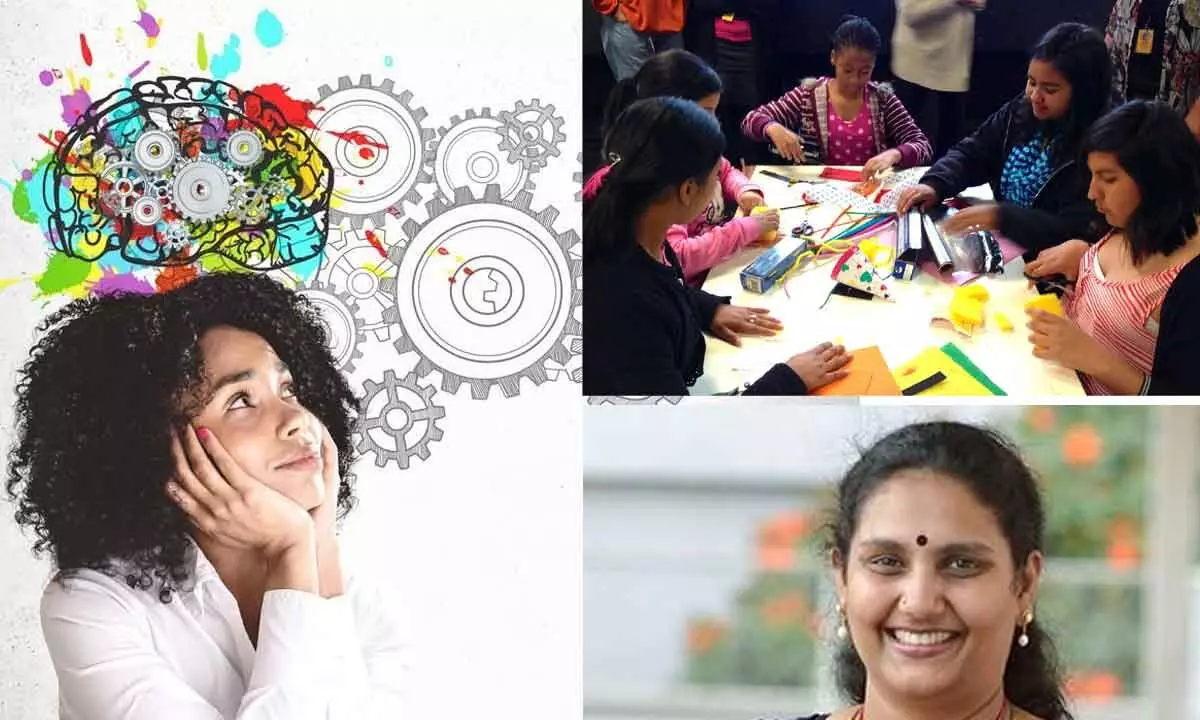Live
- Sreeleela Sparks Dating Rumors After Spotted with Ibrahim Ali Khan in Mumbai
- Revalli mandal Government is working hard for farmers' welfare: Bhatti
- Free Fire MAX Redeem Codes for January 9, 2025: Unlock Exclusive Rewards Now
- Researchers decode average life expectancy after dementia diagnosis
- Demat accounts in India hit record 185 million in 2024
- South United Football Club to host first-ever inter-city tournament to elevate grassroots football
- Cold wave: Schools in Bihar's Araria closed for classes up to 8 till January 12
- Tamil Nadu Chief Minister Stalin launches Pongal gift hampers
- Shiva Thapa, Sachin Siwach shine on Day 2 of men’s Boxing Nationals
- Agastya Hydrogen Launches 1 MW AEM Electrolyser Station and Hydrogen Refuelling Station, Advancing Green Hydrogen Innovation
Just In
Innovative design thinking as curriculum


Design - Think Design - Design Thinking
Let's analyse an everyday object. Why are the wheels of any vehicle always circular? Why do we have different application software that almost does the same thing? Why are the objects we interact with on an everyday basis? How different would these objects be if we grow tentacles?
The more significant understanding of the design of any element stems from one perspective-that design must aid a need, and to achieve that, a design must arise from deliberate thought. While the term Design resonates with most of us as an aspect of creativity or art, it also encapsulates skills such as critical thinking, research and collaboration.
A question that arises frequently is, "do we Think Design? Or do we Design Think?"
Of the many problem-solving strategies that exist, Design Thinking is an approach that provides a structured framework to arrive at solutions by addressing unstructured concerns. It provides scope to explore problems through empathy, addressing both qualitative and quantitative aspects of the ideation process across fields.
A simple example of this would be the need for multiple chair designs that essentially serve the same purpose: to support a person while sitting. But, the nuances of the design and thinking are captured by the elements such as where is the said chair designed for. Who are its users? What are the user profiles this design intends to serve? What does this chair become over a period of time- say 200 years?
Take, for example, the 'Adventure series', a GE healthcare launch attempting to solve the need for child-friendly paediatric settings - turning MRI machines from dark cave-like experiences to pirate ships, beaches, sandcastles and the ocean. These are all solutions to a specific problem statement central to the user's needs.
"Using the Design Thinking approach to solve a problem statement demands the problem solver to be mindful of the user's need for the solution and the user's need from the solution. An extensive process in which every puzzle block is treated in its entirety to gauge its worth in the BIG picture, Design thinking is a discipline of thought processes to solve layered problems" says Shobha Sivaramakrishnan, Head of Ekya Learning Centre.
At Ekya, Design Thinking is integrated into the curriculum through Design Thinking workshops for students and educators to solve broad socio-culturally relevant real-world problem statements to allow students to interact with people from varying backgrounds, explore new areas of inquiry, choose their niche of interest within the larger umbrella, explore their specific puzzle piece towards the larger statement and work towards their areas of intervention. A few statements explored in the past are - "How might we make recycling more accessible to citizens of Bengaluru?", "How might we create solutions for the growing garbage problem in Bangalore to improve the life of local citizens."
Students are presented with real-world problems/situations and Engineering design challenges in Science, Makery and Computer Science to encourage students to approach the problem statement through Design Thinking, enabling the process to be viewed as a flexible problem-solving strategy.
To list a few skills that are targeted through these challenges
♦ Challenge assumptions
♦ Accept failure
♦ Be open to criticism
♦ Creative and innovative thinking
♦ Think beyond conventional solutions
♦ Identify user needs by stepping into their shoes
♦ Empathise towards user experience
♦ Oscillate between divergent and convergent thinking during ideation
As we're moving away from traditional classroom environments to more exploratory spaces and resources to engage in learning, Design Thinking comes in as a mindset tool to incorporate flexibility, uncertainty and non-linear thinking to approach the future in education. Moving from inorganic learning methods to embracing experimentation and building holistic, interdisciplinary, creative collaboration in learners and educators, the process may not just be approached as a set of defined steps towards solving rigid problems but as building a frame of mind to approach a situation from multiple perspectives, applicable to other areas of inquiry and innovation, recognising the inherent differences between Design, and Design Think-ing even in everyday conversations.
(The writer is a Head of
Learning, Ekya Schools)

© 2025 Hyderabad Media House Limited/The Hans India. All rights reserved. Powered by hocalwire.com






